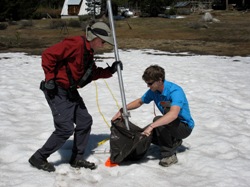
When veteran snow surveyor Frank Gehrke stuck his aluminum tube into the thinning snow course at Phillips Station this morning, the “Mount Rose” snow gauge stopped dead a few inches in. He then withdrew a sad little cylinder of corn snow, about the size of a flashlight battery. There was barely a foot of snow left at this measuring station, 6,900 feet above sea level. Water content: 35% of normal. Yikes. Of course, that’s just one station among many surveyed on a monthly basis to help handicap the coming summer’s water supply.
The numbers are in for the season’s last snow survey: On average throughout the Sierra Nevada, water content clocks in at 66% of normal for this date. Last year at this time it was 72% of normal. The southern third of the Sierra came in at 61%.
So even with that hope-lifting late-season burst of precipitation that started in mid-February, we ended up even worse than last year–at least in terms of the snowpack. Some local reservoirs filled up nicely with the soggy spring. The trouble, says Gehrke, is that “The big ones didn’t.”
Some municipal water districts have vacillated on rationing plans for the summer. But the big state and federal systems that supply irrigation water to farms have largely stuck with their drastic cuts in allocations this year.
The bottom line, according to state water director Lester Snow: “When combined with extremely dry years in 2007 and 2008, low storage in the state’s major reservoirs, restrictions on Delta pumping, a growing population and prediction of increasingly unpredictable weather patterns due to climate change, it is clear the problems facing California will persist beyond this year and this drought.”
Official drought proclamations have been a source of some controversy since the rain finally began falling in February. The Department of Water Resources has produced a statewide water plan and put it up for comment until June.
One thought on “Sierra Snow Season Ends with a Whimper”
Comments are closed.

This highlights why building more reservoirs may not be a cost-effective way to manage water resources now and in the future. Reservoirs only work if there is enough water to fill them with. In addition, evaporation is a problem with reservoir systems, and will only get worse as snow pack melts earlier and temperatures rise.